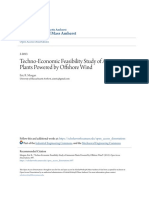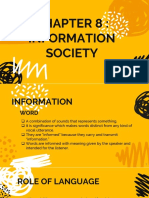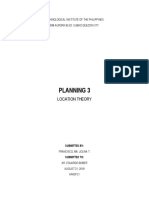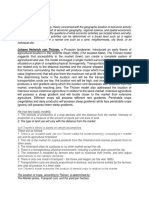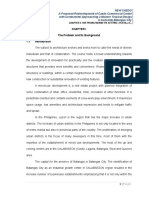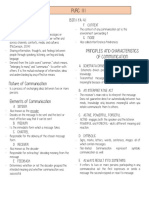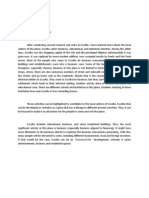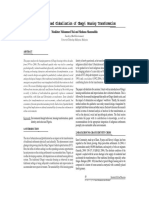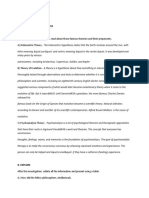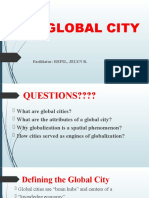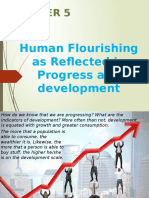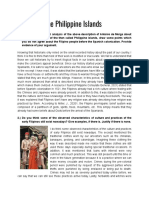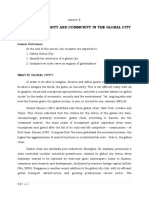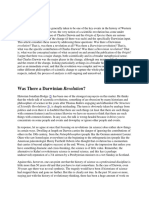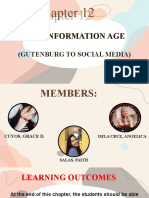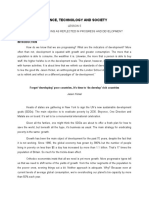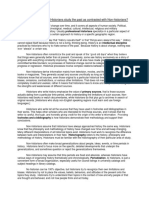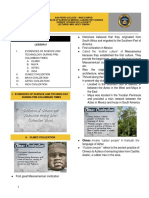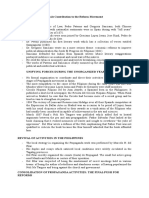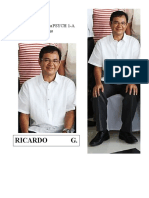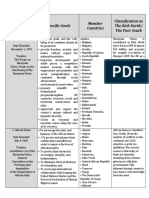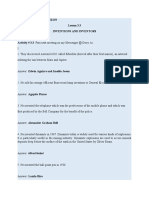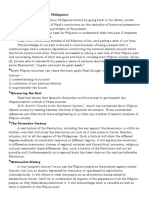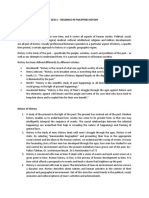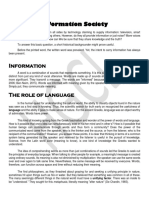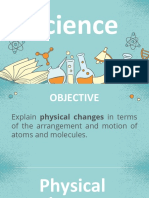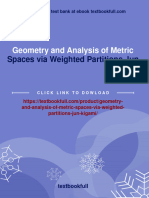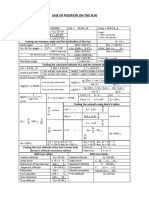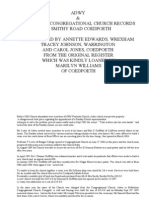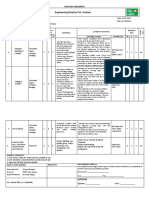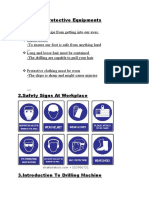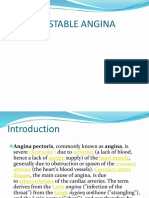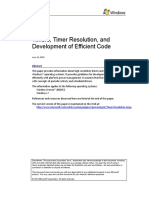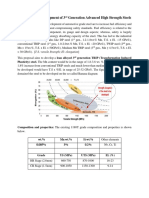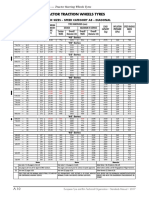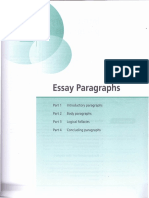Lesson 8: Information Society
Lesson 8: Information Society
Uploaded by
Ana Margarita CapuleCopyright:
Available Formats
Lesson 8: Information Society
Lesson 8: Information Society
Uploaded by
Ana Margarita CapuleOriginal Description:
Original Title
Copyright
Available Formats
Share this document
Did you find this document useful?
Is this content inappropriate?
Copyright:
Available Formats
Lesson 8: Information Society
Lesson 8: Information Society
Uploaded by
Ana Margarita CapuleCopyright:
Available Formats
LESSON 8: INFORMATION SOCIETY
● Information
➔ A word is a combination of sounds that represents something. It is this significance which makes words
distinct from just any kind of vocal utterance. Words are made up of sounds and yet they transmit
something more significant. They transmit messages. The words are “informed” because they carry
“information” Chaisson, 2006; Ben-Naim, 2015). Words are informed with the meaning given by the
speaker and intended for the listener. Simply put, they communicate meaning.
● The role of Language
➔ In the human quest for understanding the natural world, the ability to name and classify objects found
in nature was seen as a first step in knowing. Thus, the scientific search for truth early on recognized
the usefulness of language and the ability it gave to make sense of nature. For the ancient Greeks,
language was an object worthy of admiration. Words have power.
➔ This kind of knowing sprang from the Greek fascination and wonder at the power of words and
language. How is it possible that one’s idea can simultaneously exist in his/her mind and in another’s?
How is it possible that human beings can communicate through words and thus form a community?
Does the power of the communicated word come from the speaker, who is the thinker and the source,
or from the listener, who is the recipient of the communication? However you answer these points, it is
clear that thinking in terms of a common system being generated by the speaker and received by the
listener is useful in the pursuit of knowledge. Science, from the Latin word scire (meaning to know), is
one kind of knowledge the Greeks wanted to understand.
➔ The idea of comprehending words as more than just combinations of sounds led the Greeks to seek out
the principles of everyday language. When talking to other people, for example, a meaningful message
is created using ordinary sounds. Its meaning is also not diminished by multiplication---- the speaker
can use the same words over and over again to talk to ten, a hundred, or even a thousand people
separately or at the same time. Nevertheless, the same message will be received by everyone. Words,
therefore, can function across space and time without reducing their meaning.
➔ The first philosophers, as they thrashed about groping for and seeking a unifying principle in nature,
sometimes hit upon things such as fire or water. But they believed that something was common in all of
these. The many seemingly different things in the natural world must have a unifying factor. There was
an inside to be “understood”. They sought for this meta phusis, literally meaning “after nature” (De
Chardin, 1965)
➔ Plato’s principle of “One and the Many” refers to the underlying unity among diverse beings in the
natural world. For Plato, there is a common intrinsic nature shared by different objects, which
determines their real sense. Biologists devised a way to illustrate this principle using a system
differentiating between genus and species. Many species belong in one genus.
➔ In the 21st century, we are aware more than ever that there is rich diversity in nature, which technology
has allowed us to discover (BANWA Natural Science, 2008)
● MATHEMATICS AS THE LANGUAGE OF NATURE
➔ Technology in the modern world is the fruit of science. Because the scientific method helped people
discover how nature behaves, they were able to control nature with technology. A more accurate
statement is: Since people have discovered the laws and language of nature, they can develop
technology that uses these laws and language for their benefit. This language is, of course,
mathematics, the great contribution of Isaac Newton. Nature can be understood because it speaks in the
language of mathematics and the human brain, to a certain extent, can comprehend this language
(Weigner, 1960). Unfortunately, this fact is not always appreciated.
● TECHNOLOGICAL WORLD
➔ The ability to think and conceptually comprehend nature and the principles it follows eventually leads
to science. Even in ancient times, Western thinkers harnessed the forces of nature after understanding
them better. Lost in antiquity is the first sailing vessel that worked through the power of the wind.
Similarly, it was never recorded when the early people realized that fire has its own power and energy.
Not all early inventions are lost in time, however. Hero of Alexandria, for instance, would invent a
primitive steam engine in the first century (Paul Davies, 1990)
● THE PRINTING PRESS
➔ The power of the eidos, or idea, would be witnessed in the succeeding centuries of development in the
West. The ancient fascination with language gave rise to the preservation of the words of earlier people
at the same time as the West weekend itself due to internecine warfare and conflicts. Throughout this
dark period, the importance of the word-----the power to be informed as a human being-- led to the
transmission of ideas through hand-copying. From this manual action would arise the technology that
would transform cultures---the printing press. The development of the printing press, which may be
regarded as the beginning of a true revolution, could be dated to the 15th century. Through this
technology, the ancient Greek idea that knowledge should be shared and communicated among humans
would actually be pressed on a scale unimagined by its thinkers. Using the printing press, people on
different sides of the world could share their thoughts and ideas with each other, forming communities
of thinkers across space and time (Connell, 1958)
➔ The world has never looked back. This technological invention allowed words and scientific ideas to
establish a view of nature anchored in scholarly works and studies. For instance, new discoveries about
the phenomenon of electricity were eagerly absorbed by fellow scientists who then utilized the science
to create other technological products. The radio was built upon the wave nature of electricity and
magnetism, and from there, television followed.
➔ In the age of information, the transmission of ideas has undergone changes. Meaning and depth are no
longer conveyed strictly by rhetoric but rather by its electronic replacement, the digital signal or digit.
Such a digital world is a direct offspring of the progressing world of technology built upon the many
advances in science (Toffler, 1984).
● Computer
➔ Computers are among the most important contributions of advances in the Information Age to society.
A computer is an electronic device that stores and processes data (information). It runs on a program
that contains the exact, step-by-step directions to solve a problem (UShistory.org, 2017).
Types of Computer
➔ Computers are associated with numerous terms and descriptions. Most people suggest the
dimensions, intended use, or the computer's power. While the term "computer" can apply to
virtually any device that has a microprocessor in it, most people think of a computer as a
device that receives input from the user through a mouse (hand-guided directions tool) or
keyboard, processes it in some fashion, and presents the result on a screen.
1. Personal Computer (PC)
➔ It is a single-user instrument. PCs were first known as microcomputers since they were a
complete computer but built on a smaller scale than the enormous systems operated by most
businesses.
2. Desktop Computer
➔ It is described as a PC that is not designed for portability. The assumption with a desktop is
that it will be set up in a permanent spot. A workstation is simply a desktop computer that has a
more powerful processor, additional memory, and enhanced capabilities for performing special
groups of tasks, such as 3D graphics or game development. Most desktops offer more storage,
power, and versatility than their portable versions (UShistory.org, 2017).
3. Laptops
➔ These are portable computers that integrate the essentials of a desktop computer in a
battery-powered package, which are somewhat larger than a typical hardcover book. They are
commonly called notebooks.
4. Personal Digital Assistants (PDAs)
➔ These are tightly integrated computers that usually have no keyboards but rely on a touch
screen for user input. PDAs are typically smaller than a paperback, lightweight, and battery-
powered (UShistory.org, 2017).
5. Server
➔ It refers to a computer that has been improved to provide network services to other computers.
Servers usually boast powerful processors, tons of memory, and large hard drives
(UShistory.org, 2017).
6. Mainframes
➔ These are huge computer systems that can fill an entire room. They are used especially by
large firms to describe the large, expensive machines that process millions of transactions
every day. The term "mainframe" has been replaced by enterprise server. Although some
supercomputers are single computer systems, most comprise multiple, high-performance,
parallel computers working as a single system (UShistory.org, 2017).
7. Wearable Computers
➔ They involve materials that are usually integrated into cell phones, watches, and other small
objects or places. They perform common computer applications such as databases, email,
multimedia, and schedulers (UShistory.org, 2017).
● THE WORLD WIDE WEB
➔ A more modern example of technology feeding upon itself is the 20th century tour de force: the World
Wide Web through the internet. Sir Tim Berners-Lee invented it as a way of addressing data processing
and information sharing needs among scientists for the European Organization for Nuclear Research
(CERN). CERNS’s atoms smash a huge amount of scientific data every second. It thus required better
data analyzers to work on the gathered information in coordination with each other. While the
telegraph and telephone had allowed the transmission of information to transcend physical boundaries,
processing a veritable ocean and mountain of scientific data generated by the atom smasher needed a
new medium.
➔ With the ease of sharing information at present, its reliability becomes compromised. Anyone with a
connection to other people can produce contents which are showing half-truths or even lies, giving rise
to disinformation. Social media also encourages building a community of like-minded people. The
creation of these groups often reinforces biases and beliefs based only on the content that they allow
within the community, forgoing the variation and clash of ideas provided in real life. Worse, these
communities can be tapped by people in power who may take advantage of these
mechanisms---controlling public opinion and harassing those who present opposing views--- for their
own advantage. Meanwhile, the easy access to personal information makes one susceptible to online
predation, identity theft, and scamming, among others. Thus, it pays to be vigilant in utilizing these
modern devices at all times.
➔ The technology applied when a sailor up a piece of cloth to catch the wind is the same one that
produces modern machines and devices, albeit less complex. Nevertheless, human beings have always
found a way to address their needs and discover new frontiers with scientific thinking. Considering the
many benefits we get from these technologies, we must also be responsible in utilizing them to avoid
harming others and ourselves.
Reference;
McNamara SJ, D., Valverde, V & Beleno III, R. (2018). Science, Technology and Society (pp. 86-95).
You might also like
- Petrol Bills CompressDocument1 pagePetrol Bills Compressramesh shelke67% (3)
- A Nation Aborted Summary NotesDocument5 pagesA Nation Aborted Summary NotesKate RañocoNo ratings yet
- Techno-Economic Feasibility Study of Ammonia Plants Powered by of PDFDocument432 pagesTechno-Economic Feasibility Study of Ammonia Plants Powered by of PDFMohammed Al Breiki75% (4)
- Chapter 8 Sts ReportingDocument19 pagesChapter 8 Sts ReportingNeshren EbnoNo ratings yet
- ReportDocument25 pagesReportJunneth Pearl HomocNo ratings yet
- Information SocietyDocument28 pagesInformation SocietyBritney ApasNo ratings yet
- High-Rise Living in Singapore Public HousingDocument18 pagesHigh-Rise Living in Singapore Public HousingMalik AhmadNo ratings yet
- Planning Ass. ThursDocument7 pagesPlanning Ass. ThursJolens FranciscoNo ratings yet
- Location Theory: Johann Heinrich Von Thünen, A Prussian Landowner, Introduced An Early Theory ofDocument5 pagesLocation Theory: Johann Heinrich Von Thünen, A Prussian Landowner, Introduced An Early Theory ofArellano SastroNo ratings yet
- Urban Utopias in The 20th CenturyDocument1 pageUrban Utopias in The 20th CenturyDanica Lyne Dela CruzNo ratings yet
- Religion of Asian PeopleDocument13 pagesReligion of Asian PeopleJr YuNo ratings yet
- STS ReviewerDocument6 pagesSTS ReviewerPrincess Lheakyrie CasilaoNo ratings yet
- Final To Print Chapter 1 PDFDocument16 pagesFinal To Print Chapter 1 PDFMary LlegadoNo ratings yet
- Purc Transes PrelimDocument4 pagesPurc Transes PrelimGelo AlonzoNo ratings yet
- Reflection On EscoltaDocument3 pagesReflection On EscoltaJenny Jane Sarmiento VeraqueNo ratings yet
- Gbagyi Culture and ValuesDocument10 pagesGbagyi Culture and ValuesSylvester Ejembi InnocentNo ratings yet
- Gecsts Module 2 Agustin, April Joy B. Bped-1B A. EngageDocument3 pagesGecsts Module 2 Agustin, April Joy B. Bped-1B A. EngageApril joy AgustinNo ratings yet
- Global CityDocument12 pagesGlobal CityAngie LumbayNo ratings yet
- RPH FinalsDocument9 pagesRPH FinalsJosiah Cedric De LeonNo ratings yet
- Sts and Civilization: Historical Antecedents in The Course of Science and TechnologyDocument22 pagesSts and Civilization: Historical Antecedents in The Course of Science and TechnologyXavier GonzalesNo ratings yet
- Housing The Poor: A Vehicle For Economic Empowerment and Poverty Alleviation A Study of Warri Delta State NigeriaDocument52 pagesHousing The Poor: A Vehicle For Economic Empowerment and Poverty Alleviation A Study of Warri Delta State NigeriaJoshua Israel OrizuNo ratings yet
- Human Flourishing As Reflected in Progress and DevelopmentDocument21 pagesHuman Flourishing As Reflected in Progress and DevelopmentMICKEL DUNGCA100% (1)
- Module 4 Assessment 1Document2 pagesModule 4 Assessment 1Angela Beatrice100% (1)
- Reading 3 - Cracks in The ParchmentDocument3 pagesReading 3 - Cracks in The ParchmentNoobMaster69No ratings yet
- Autonomy ReportDocument4 pagesAutonomy ReportWynona CaloNo ratings yet
- Module 3, Ge STSDocument3 pagesModule 3, Ge STSJAYSON NIFALARNo ratings yet
- History of The Philippine IslandsDocument2 pagesHistory of The Philippine IslandsskzrachaNo ratings yet
- Lesson 8 - Global CityDocument5 pagesLesson 8 - Global CityELLE GONZALESNo ratings yet
- Darwinian REVOLUTIONDocument4 pagesDarwinian REVOLUTIONDickston Alojado100% (1)
- 3 San Juan Batangas Leon Mayo Paper PDFDocument51 pages3 San Juan Batangas Leon Mayo Paper PDFIvan GonzalesNo ratings yet
- A La Juventud Filipina or To The Filipino YouthDocument2 pagesA La Juventud Filipina or To The Filipino YouthClyde PeraltaNo ratings yet
- The Information Age: (Gutenburg To Social Media)Document18 pagesThe Information Age: (Gutenburg To Social Media)Dela Cruz, Angelica M.No ratings yet
- CHAPTER 1 Introduction To HistoryDocument53 pagesCHAPTER 1 Introduction To HistoryAngie Cadorna0% (1)
- Topic 7 Ethical DilemmaDocument15 pagesTopic 7 Ethical DilemmaMary Angelie SarolNo ratings yet
- STS Online Class Lesson 1Document6 pagesSTS Online Class Lesson 1Mark MalolesNo ratings yet
- The Global City Final 0.001Document6 pagesThe Global City Final 0.001Jade SagarioNo ratings yet
- What Is History? How Do Historians Study The Past As Contrasted With Non-Historians?Document1 pageWhat Is History? How Do Historians Study The Past As Contrasted With Non-Historians?Melvin Bombasi ArciagaNo ratings yet
- Veritas 114 Reviewer Week 2 Community Engagement: Community Engagement in Our Lady of Fatima UniversityDocument10 pagesVeritas 114 Reviewer Week 2 Community Engagement: Community Engagement in Our Lady of Fatima UniversityAira Manuba MozoNo ratings yet
- ACTIVITY PORTFOLIO GECART - Kimberly de JesusDocument9 pagesACTIVITY PORTFOLIO GECART - Kimberly de JesusKimberly De JesusNo ratings yet
- The Philippines A Century Hence: Collaboration With Ms. Shanise Geri Villanueva Edited By: Maria Bernadette RedDocument4 pagesThe Philippines A Century Hence: Collaboration With Ms. Shanise Geri Villanueva Edited By: Maria Bernadette RedJerrick Bryan NganNo ratings yet
- Purposive Communication - Unit 1 - Chapter 2 PDFDocument7 pagesPurposive Communication - Unit 1 - Chapter 2 PDFRain Storm PolgaderaNo ratings yet
- GEC 3 ModuleDocument182 pagesGEC 3 ModuleChristian Zen AbarientosNo ratings yet
- Lesson 5 - STS 100 - Science and Technology in Pre-Columbian TimesDocument5 pagesLesson 5 - STS 100 - Science and Technology in Pre-Columbian TimesJuren LasagaNo ratings yet
- The Resolute PropagandistDocument6 pagesThe Resolute PropagandistAgnes Arima100% (2)
- 10-The Nano World and Gene TherapyDocument9 pages10-The Nano World and Gene Therapyrose belle garciaNo ratings yet
- Education and Economic Development in The Early American Period in The PhilippinesDocument14 pagesEducation and Economic Development in The Early American Period in The PhilippinesmarcheinNo ratings yet
- Contem. World Lesson 3Document6 pagesContem. World Lesson 3Casey Collera Mediana100% (1)
- Ricardo G. Sigua: Kristine Joy Halili Harolyn Manansala PSYCH 1-A Joshua Kale Lozano Ray Carl GarciaDocument8 pagesRicardo G. Sigua: Kristine Joy Halili Harolyn Manansala PSYCH 1-A Joshua Kale Lozano Ray Carl GarciaDonna Rose Sanchez FegiNo ratings yet
- The Luistanian-Hispanic Rivalry in Maritime Discoveries & TheDocument3 pagesThe Luistanian-Hispanic Rivalry in Maritime Discoveries & TheMay RomanNo ratings yet
- Profile of The Regional Economic Integration Specific Goals Member Countries Classification As The Rich North/ The Poor SouthDocument7 pagesProfile of The Regional Economic Integration Specific Goals Member Countries Classification As The Rich North/ The Poor SouthteuuuuNo ratings yet
- The Theory of Demographic Transition (With Criticisms) : (A Critique About Population Growth)Document6 pagesThe Theory of Demographic Transition (With Criticisms) : (A Critique About Population Growth)Liezl LachicaNo ratings yet
- Manunggul JarDocument3 pagesManunggul JarKaela Madrunio100% (1)
- Name: Jorenal C. Benzon Lesson 3.3 Inventions and InventorsDocument3 pagesName: Jorenal C. Benzon Lesson 3.3 Inventions and InventorsJorenal BenzonNo ratings yet
- The Historian's Task in The PhilippinesDocument3 pagesThe Historian's Task in The PhilippinesMace MaclangNo ratings yet
- Chapter 1 PDFDocument22 pagesChapter 1 PDFJessa Clarisse CrisostomoNo ratings yet
- Meaning Nature and Relevance of HistoryDocument3 pagesMeaning Nature and Relevance of HistoryLLOYD AXCEL QUINLOGNo ratings yet
- The Perceived Impact of Historical Heritage Preservation On The Cultural Identity of Architecture Students in The City of MalolosDocument16 pagesThe Perceived Impact of Historical Heritage Preservation On The Cultural Identity of Architecture Students in The City of MalolosDarlene ivyNo ratings yet
- Population and Human Ecology HANDOUTDocument11 pagesPopulation and Human Ecology HANDOUTMary Rose Bobis VicenteNo ratings yet
- ArtesDocument45 pagesArtesportiadeportia0% (2)
- Critically Assess The Claim That Conscience Is The Voice of Reason FinDocument3 pagesCritically Assess The Claim That Conscience Is The Voice of Reason FinAdy CookNo ratings yet
- Chapter 8 Information SocietyDocument22 pagesChapter 8 Information SocietyMay Joy ApinanNo ratings yet
- Chapter 8Document5 pagesChapter 8SchmelNo ratings yet
- Week 3 (Lesson Proper)Document26 pagesWeek 3 (Lesson Proper)Ana Margarita CapuleNo ratings yet
- Week 3 (Lesson Proper) Part 2Document14 pagesWeek 3 (Lesson Proper) Part 2Ana Margarita CapuleNo ratings yet
- Week 2 (Lesson Proper)Document20 pagesWeek 2 (Lesson Proper)Ana Margarita CapuleNo ratings yet
- Ions QuizDocument6 pagesIons QuizAna Margarita CapuleNo ratings yet
- Full Geometry and Analysis of Metric Spaces Via Weighted Partitions Jun Kigami Ebook All ChaptersDocument53 pagesFull Geometry and Analysis of Metric Spaces Via Weighted Partitions Jun Kigami Ebook All Chaptersdonissnarong100% (4)
- Outdoor Air Switches Selection and Application: 8.25 Thru 800 KV Max. Voltage 600 Thru 5000 Amperes Bulletin 2.3.1-1FDocument18 pagesOutdoor Air Switches Selection and Application: 8.25 Thru 800 KV Max. Voltage 600 Thru 5000 Amperes Bulletin 2.3.1-1FannymagoNo ratings yet
- Module-2-Hysys Simulation Manual CE-603Document29 pagesModule-2-Hysys Simulation Manual CE-603Zain ShahjeeNo ratings yet
- Exercitii LOP SunDocument5 pagesExercitii LOP SunAnca IosifNo ratings yet
- Adwy Chapel HistoryDocument18 pagesAdwy Chapel HistoryAnnette Edwards100% (2)
- Compiled By: Tanveer M Malik (17122) Atif Abbas Faizan Puri - 13368 MaheshDocument38 pagesCompiled By: Tanveer M Malik (17122) Atif Abbas Faizan Puri - 13368 MaheshM.TalhaNo ratings yet
- TRA CylindersDocument2 pagesTRA Cylindersaparna_losariNo ratings yet
- T30 BrochureDocument2 pagesT30 Brochuremostafa.mohamed.19955No ratings yet
- Liver CirrhosisDocument31 pagesLiver CirrhosisAsniah Hadjiadatu Abdullah100% (1)
- Clinical Nutrition The Interface Between Metabolism, Diet, and DiseaseDocument438 pagesClinical Nutrition The Interface Between Metabolism, Diet, and DiseaseCris Portillo100% (6)
- How To Construct The Right Daily DeclarationsDocument34 pagesHow To Construct The Right Daily DeclarationsVivienne IrvingNo ratings yet
- Checklist For Boiler MFT Protection Checklist: Sl. No. MFT Conditions Interlocks Simulation Methodology Result RemarksDocument4 pagesChecklist For Boiler MFT Protection Checklist: Sl. No. MFT Conditions Interlocks Simulation Methodology Result RemarksAvadhesh TiwariNo ratings yet
- SIM On WorkDocument28 pagesSIM On WorkJanalin TatilNo ratings yet
- Skills Pack: Cambridge IGCSE Physics 0625Document30 pagesSkills Pack: Cambridge IGCSE Physics 0625farooqNo ratings yet
- 1.personal Protective EquipmentsDocument5 pages1.personal Protective EquipmentsRexana RheaNo ratings yet
- 06 Power Supply and Electrification Strategy in The PhilippinesDocument19 pages06 Power Supply and Electrification Strategy in The Philippinesvishans100% (1)
- Unstable AnginaDocument29 pagesUnstable AnginaniaNo ratings yet
- Peritoneal DialysisDocument17 pagesPeritoneal DialysisIan Benedict GuerreroNo ratings yet
- Specify Better Low NOx Burnersfor FurnacesDocument5 pagesSpecify Better Low NOx Burnersfor Furnacesjacquesstrappe06No ratings yet
- Med-Surg Ch25 Patient With Cancer Study Guide and NCLEX QuestionsDocument19 pagesMed-Surg Ch25 Patient With Cancer Study Guide and NCLEX QuestionsKyla Mae JumaritoNo ratings yet
- Hyperplas Polyester Membrane - TDS PDFDocument4 pagesHyperplas Polyester Membrane - TDS PDFGanesh MurthyNo ratings yet
- Timers, Timer Resolution, and Development of Efficient Code: June 16, 2010Document11 pagesTimers, Timer Resolution, and Development of Efficient Code: June 16, 2010Слава КоноваленкоNo ratings yet
- Synchronous Motor Excitation - Electrical4u PDFDocument5 pagesSynchronous Motor Excitation - Electrical4u PDFRishiSunariyaNo ratings yet
- 3rd Gen AHSS Concept NoteDocument3 pages3rd Gen AHSS Concept NoteAnonymous s0ZgKUaie9No ratings yet
- Tractor Traction Wheels TyresDocument14 pagesTractor Traction Wheels Tyresmehmed şahinNo ratings yet
- Essay Paragraphs: Introductory Paragraphs Body Paragraphs Logical Fallacies Concluding ParagraphsDocument42 pagesEssay Paragraphs: Introductory Paragraphs Body Paragraphs Logical Fallacies Concluding ParagraphsThanh Ngân Lưu HoàngNo ratings yet
- Lateral Earth Pressure Due To Vibratory Rollers PDFDocument11 pagesLateral Earth Pressure Due To Vibratory Rollers PDFchutton681No ratings yet


